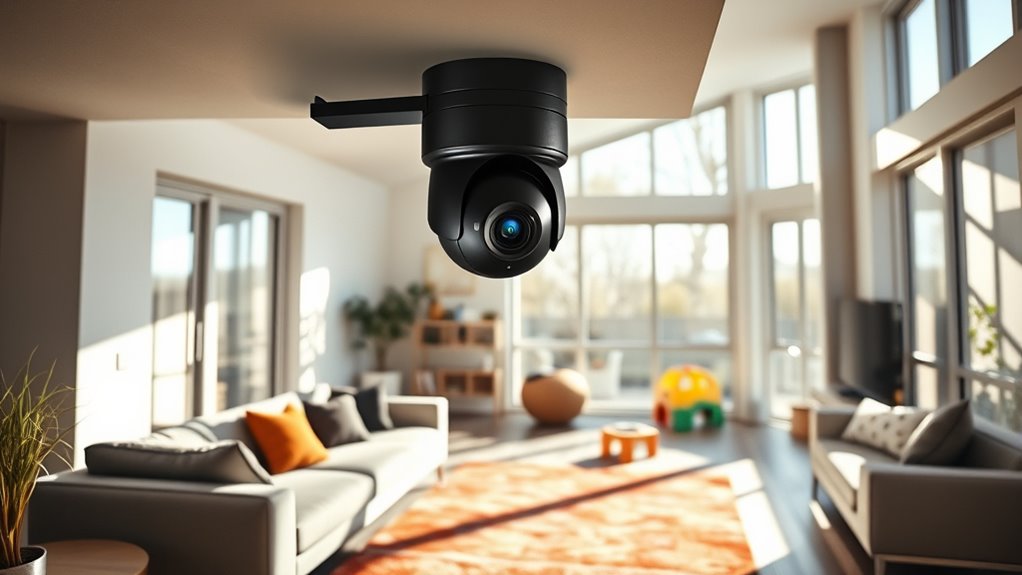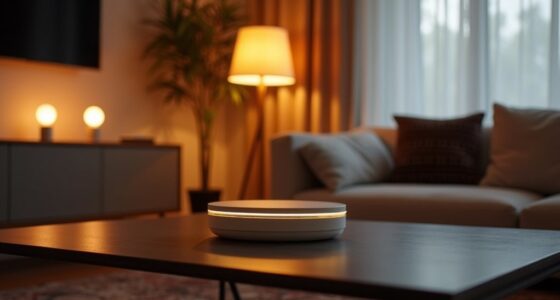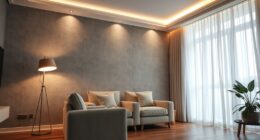To effectively place indoor security cameras, focus on high-traffic areas like entryways, hallways, and common spaces such as living rooms and kitchens. Position cameras 8 to 10 feet high, angling them downward at about 30 degrees for ideal visibility. Avoid bedrooms and bathrooms to respect privacy. Regularly check angles and lighting to maintain video quality. By following these tips, you’ll maximize security while ensuring privacy. There’s more to discover about effective camera placement and considerations.
Key Takeaways
- Install cameras in high-traffic areas like entryways and hallways to monitor access points effectively.
- Position cameras in common areas such as living rooms and kitchens for visibility on family interactions and visitors.
- Avoid placing cameras in bedrooms and bathrooms to respect privacy and comply with local laws.
- Mount cameras at a height of 8 to 10 feet with a downward angle of about 30 degrees for optimal coverage.
- Regularly assess camera angles and lighting to maintain video quality and avoid glare from windows.
Key Locations for Indoor Security Cameras
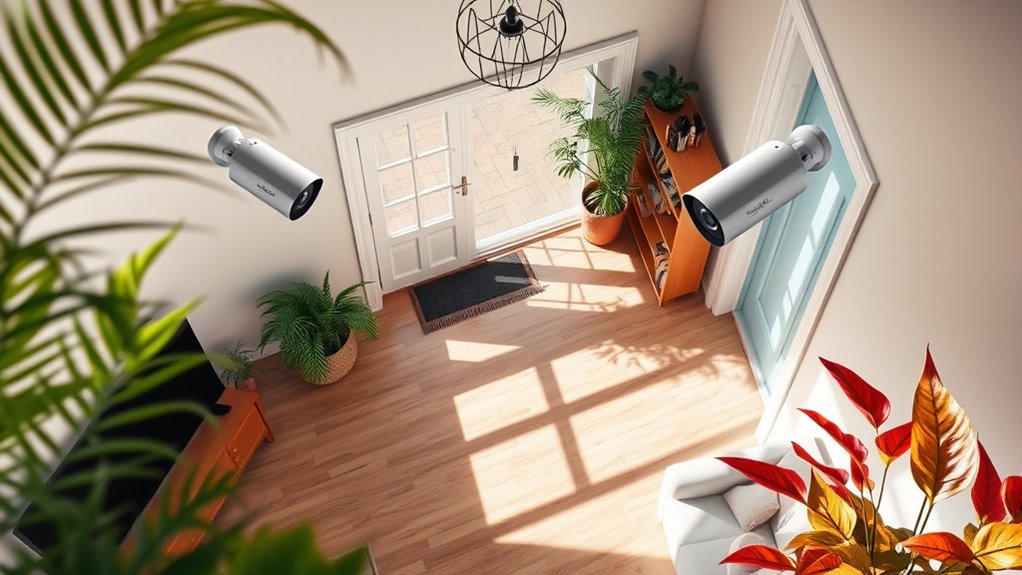
When deciding where to place your indoor security cameras, consider focusing on key locations that enhance your home’s safety.
Prioritize high-traffic areas, like entryways and hallways, to effectively monitor access points and capture movement throughout your home. Common areas, such as living rooms and kitchens, are also ideal for camera placement, allowing you to observe family interactions and visitors. Additionally, placing cameras in high-traffic areas can help you keep a closer eye on who is entering and exiting your home. Installing cameras in these locations can also align with professional monitoring options for enhanced security. Furthermore, integrating your cameras with smart home devices can provide additional layers of security and control. Incorporating natural elements can create a more inviting atmosphere while ensuring safety measures are in place.
Don’t forget to position cameras in rooms with valuable items, like basements and offices, to deter potential theft. Install cameras at a height of 8 to 10 feet to maximize coverage and reduce the risk of tampering. Additionally, maintaining a clean living space can help ensure that your cameras operate effectively without obstructive debris affecting visibility.
Finally, respect privacy considerations by avoiding placement in bedrooms and bathrooms to guarantee legal compliance and maintain a comfortable home environment.
Common Areas to Monitor
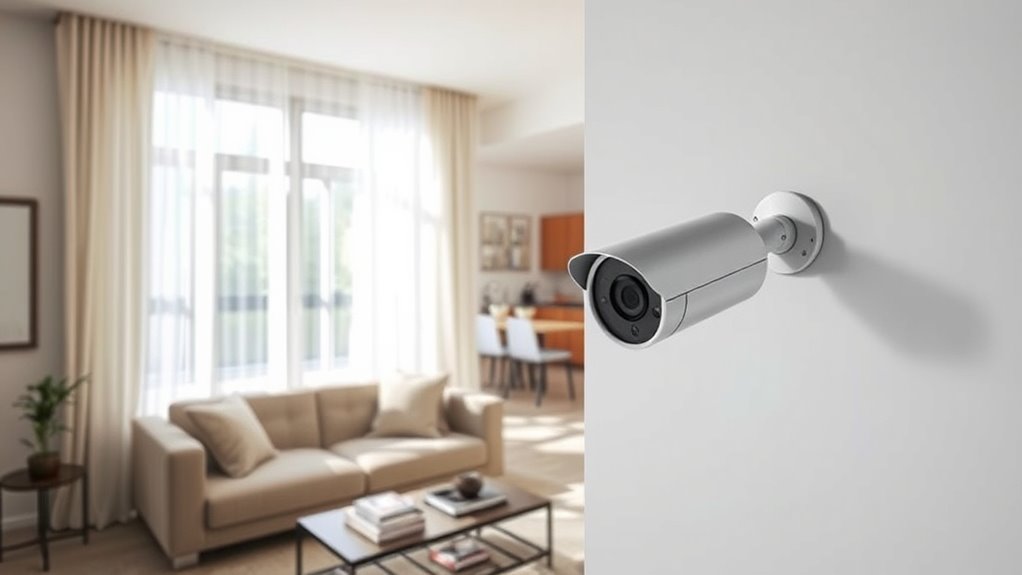
When setting up your indoor security cameras, focus on common areas like the living room, hallway, and kitchen. These spaces see a lot of activity, making them ideal for monitoring daily life and ensuring everyone’s safety. Additionally, the presence of security systems can deter potential burglars and enhance the overall security of your home. Installing security cameras in these areas can also improve the user experience by allowing homeowners to monitor activities in real-time. Furthermore, the use of efficient heating systems in conjunction with security cameras can create a safer and more comfortable environment. Implementing security measures can also help reduce the risk of cognitive decline in vulnerable individuals by ensuring their safety and well-being. Moreover, having Alzheimer bracelets for seniors in these monitored areas can further enhance their safety and provide critical identification in emergencies.
Living Room Surveillance
Positioning indoor security cameras in your living room is essential for monitoring high-traffic areas where family and visitors often gather. This space usually houses valuable items like electronics and furniture, making surveillance vital for your security. Cameras should be installed at 8 to 10 feet to enhance coverage and minimize tampering risks. Aim for models with a wide field of view (at least 130 degrees) to capture all activities without blind spots. Monitoring your living room can also provide peace of mind while keeping an eye on children and pets as they play.
| Camera Location | Purpose | Key Features |
|---|---|---|
| Above Sofa | Monitor visitors | Wide field of view |
| Near Entrance | Capture entry/exit | Height to prevent tampering |
| By TV Unit | Protect valuable items | Motion detection |
| Corner of Room | Oversee entire area | 130-degree coverage |
| Near Play Area | Watch children/pets | Live streaming |
Hallway Monitoring Areas
Hallways are vital access points in your home, making them ideal locations for indoor security cameras. Proper placement in these areas enhances monitoring, guaranteeing you capture any movement throughout your home. By installing cameras at a height of 8 to 10 feet, you maximize coverage while reducing the risk of tampering or obstruction. A wide-angle lens is fundamental, allowing you to effectively monitor the entire corridor and any adjoining rooms. This setup is significant for capturing footage of intruders attempting to navigate between rooms. Additionally, a higher contrast ratio in the camera’s image quality can help you identify details in low-light conditions, further improving security. Furthermore, using portable camping toilets can keep your indoor environment clean and comfortable during unexpected situations. Regularly checking the air quality indicators of your home can also help ensure that the environment is safe for your family.
Furthermore, implementing risk management strategies for indoor surveillance can enhance your overall security approach. Additionally, monitoring hallways helps assure the safety of children, pets, and household help, providing peace of mind as you protect your home from potential threats. Furthermore, a well-organized environment can enhance mental clarity, allowing you to respond quickly to any security concerns.
Kitchen Activity Observation
The kitchen serves as a bustling hub in most homes, making it a prime spot for security cameras. With around 63% of households gathering here, monitoring activities can enhance safety and home security.
Here are key reasons to install cameras in your kitchen:
- Monitor children and pets: Keep an eye on little ones and furry friends while you cook or entertain. This practice can also promote overall health by ensuring that snacks and meals are prepared safely. Additionally, keeping an eye on the kitchen can help families navigate the caregiving journeys of their loved ones, ensuring everyone stays safe and secure. Furthermore, fostering a growth mindset can encourage children to develop independence and responsibility in the kitchen.
- Oversee deliveries: Confirm packages are received and food safety protocols are followed, especially with perishables. Additionally, ensuring you have high-quality pellets available for pet care can help maintain a safe environment for them.
- Strategic placement: Positioning cameras at a height of 8 to 10 feet gives a wide field of view while minimizing tampering risks.
Additionally, using security cameras in the kitchen can help ensure that required minimum distributions are properly managed, especially if you have investments linked to your home or property.
Height and Angle Considerations
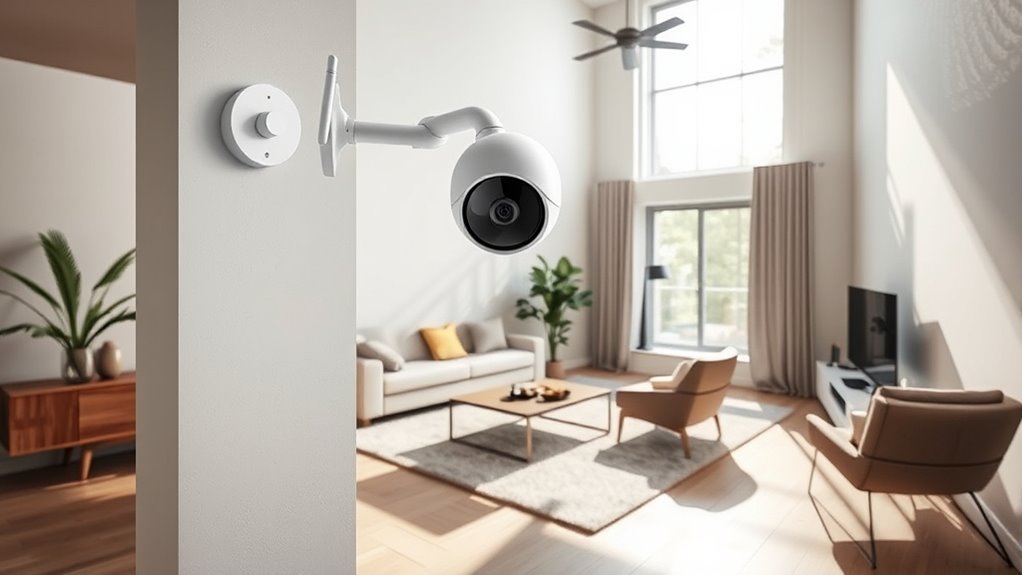
When setting up your indoor security cameras, consider the height and angle for ideal performance. Positioning them about 8 to 10 feet high can help you avoid obstructions, while angling them downward at around 30 degrees captures clearer images. Additionally, steer clear of placing cameras in front of windows to prevent glare that can compromise image quality. Ensuring proper airflow around the unit can enhance the performance of other devices in the area, including air purifiers. Incorporating natural elements in the surrounding decor can also create a more aesthetically pleasing environment while maintaining effective surveillance. Using surge protection for your cameras can further ensure their reliability during power surges. Furthermore, choosing the right investment strategy for your security system can improve its long-term effectiveness and ensure you get the best value for your money.
Optimal Camera Height
For ideal security coverage, position your indoor cameras between 8 to 10 feet high. This best camera height maximizes coverage while minimizing the risk of tampering.
A downward angle of about 30 degrees is recommended to effectively capture faces and movements without compromising the camera’s field of view.
Consider these tips for placement:
- Securely mount cameras out of reach to prevent unauthorized adjustments.
- Avoid placing them directly in front of windows to prevent glare and reflection issues.
- Position cameras in the corners of rooms to monitor multiple areas simultaneously.
Effective Angle Positioning
Positioning indoor security cameras at the right angle is essential for capturing clear and effective footage. To maximize coverage and prevent tampering, mount cameras at a height of 8 to 10 feet with a 30-degree downward tilt. This ideal angle guarantees that you can clearly see individuals entering high-traffic areas and potential entry points.
| Camera Placement | Coverage Focus |
|---|---|
| Corners | Multiple room perspectives |
| Hallways | High-traffic areas |
| Living Spaces | Entry points |
Minimize Reflection Issues
To effectively minimize reflection issues with indoor security cameras, it’s essential to take into account both height and angle.
Here are some placement tips to guarantee peak video quality:
- Position cameras at a height of 8 to 10 feet for maximum coverage and a clear line of sight.
- Angle cameras slightly downward, ideally at a 30-degree angle, to capture faces and movements while reducing glare.
- Avoid placing cameras directly facing windows or reflective surfaces to prevent washed-out footage.
Consider using cameras with High Dynamic Range (HDR) technology to manage glare effectively in varying light conditions.
Regularly assess your camera angles and lighting to maintain peak performance and guarantee you get the best quality footage possible.
Areas to Avoid for Privacy
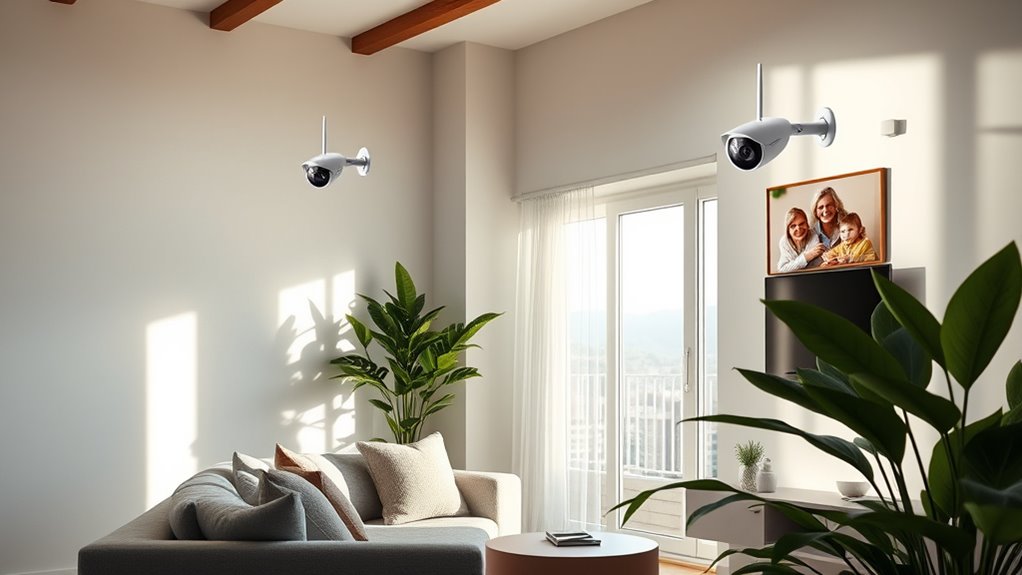
While it’s tempting to place cameras in every corner of your home for added security, some areas should be off-limits to respect privacy. Consider the following spaces that warrant caution:
| Area | Reason |
|---|---|
| Bedrooms | High expectation of privacy; personal space |
| Bathrooms | Little security value; infringes privacy |
| Dressing Rooms | Confidential spaces; trust erosion |
| Private Offices | Legal issues; unmonitored surveillance |
Installing cameras in these areas can violate personal privacy and state laws. You could face legal repercussions for monitoring spaces where individuals expect to be unobserved. To maintain trust and confidentiality, keep these areas camera-free. Always stay informed about local regulations regarding surveillance to guarantee compliance and protect everyone’s rights.
Tips for Effective Indoor Camera Placement

Respecting privacy is important, but that doesn’t mean you can’t enhance your home’s security with effective indoor camera placement.
To optimize your indoor security cameras, consider these tips:
- Position cameras in high-traffic areas like entryways, hallways, and common living spaces to monitor daily activities.
- Make certain cameras are angled properly to capture a broad area without pointing directly at windows, which can cause glare.
- Install cameras at a height of 8 to 10 feet to prevent tampering while maintaining good visibility.
Legal Considerations for Indoor Camera Installation
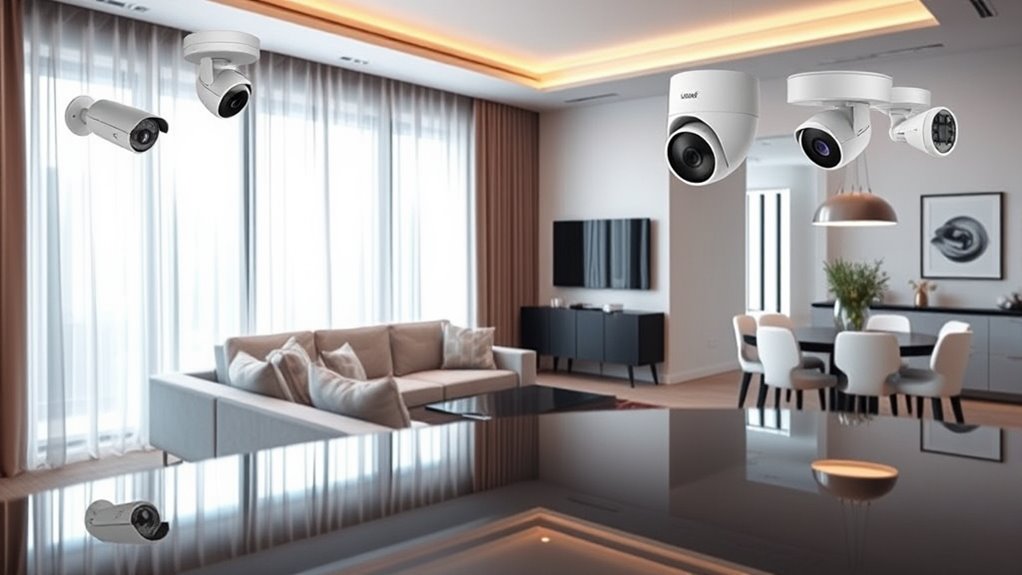
Before installing indoor security cameras, you should be aware of the legal considerations that come into play. Different local laws govern surveillance, so check the regulations in your area.
Remember, individuals have a reasonable expectation of privacy in spaces like bedrooms and bathrooms, making it illegal to install cameras there without consent. Some jurisdictions require clear signage to inform guests about surveillance, promoting transparency.
Also, avoid pointing cameras at areas where privacy is expected, like neighboring properties, to prevent unwarranted surveillance claims.
Finally, research any homeowner association rules or community guidelines that may impact your camera placement. Ensuring compliance not only protects your guests’ privacy but also safeguards you from potential legal repercussions.
Frequently Asked Questions
Where Not to Install Security Cameras?
You shouldn’t install security cameras in areas where privacy is expected.
Avoid placing them in bedrooms and bathrooms, as this can violate personal space and trust.
Don’t put cameras on neighbors’ property either, since that can lead to legal issues and disputes.
Additionally, steer clear of high-privacy zones like changing rooms, where surveillance could infringe on individual rights.
Always check local laws and homeowner association guidelines to guarantee compliance.
Where Is the Best Place to Put a Home Security Camera?
When you’re deciding where to put a home security camera, focus on high-traffic areas like entryways and living rooms.
Position your cameras at a height of 8 to 10 feet, angled slightly down to capture the most activity while deterring tampering. Corners are great spots, as they offer a wider view.
Just remember to avoid private spaces to respect privacy, and make certain your cameras are visible to deter intruders effectively.
Should Home Security Cameras Be Visible?
Did you know that around 60% of burglars avoid homes with visible security cameras? So, yes, home security cameras should be visible. Their presence can deter potential intruders, making them think twice before targeting your property.
However, you might want to balance visibility with discretion. Placing cameras in high-traffic areas guarantees they’re noticeable, while strategic positioning can protect your valuables from unwanted attention.
Ultimately, it’s about maximizing security while minimizing risks.
What Is the Best Viewing Angle for a Security Camera?
The best viewing angle for your security camera is between 30-45 degrees downward.
This angle guarantees you capture entry points and high-traffic areas effectively while minimizing blind spots.
Positioning your camera in a corner can give you a wider field of view.
Aim to mount it 8 to 10 feet high to prevent tampering, and consider using cameras with Wide Dynamic Range (WDR) to improve image clarity in varying lighting conditions.
Conclusion
Ultimately, placing your indoor security cameras thoughtfully is like crafting a protective web around your home. By monitoring key areas and respecting privacy, you create a safe haven for your family. Remember to take into account height, angles, and legal guidelines to guarantee effective surveillance. With the right camera placements, you can keep a watchful eye on what matters most, providing peace of mind while you go about your daily life. Stay vigilant and secure!
